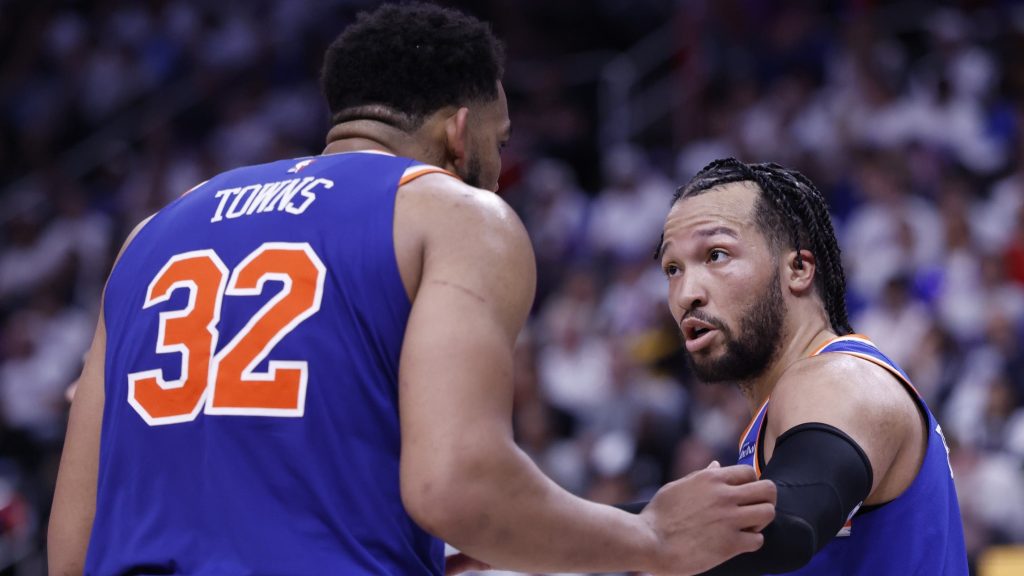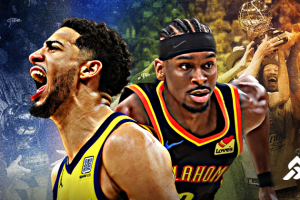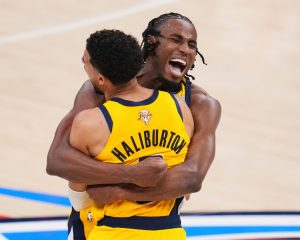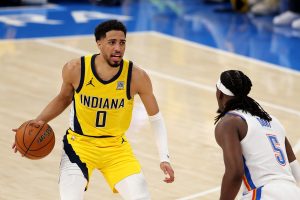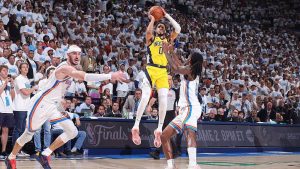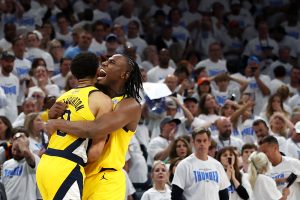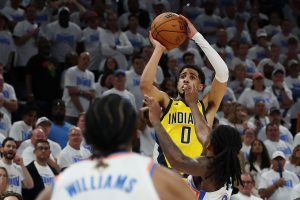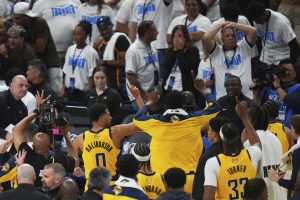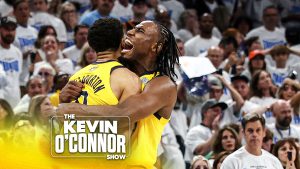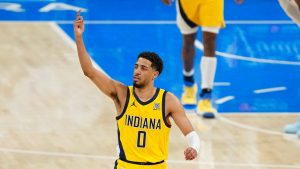When the Knicks first paired Jalen Brunson and Karl-Anthony Towns, the offensive possibilities seemed endless. Brunson is one of the best shot creators in the NBA and has elevated as a three-point shooter, especially off the dribble.
Towns is one of the best shooting big men in NBA history. And the stats show it. Towns shot 42 percent from deep during the 2024-25 season and is a career 40 percent shooter from three. The pairing of the two All-Stars worked in a general sense. New York won 51 games and advanced to the Conference Finals.
Brunson (26.0 points) and Towns (24.4 points) both made All-NBA teams and were productive on the floor. But beyond the individual stats, Brunson and Towns didn’t find ideal balance. Both players seemed like two ships passing in the night.
Initially, the Brunson-Towns pick-and-roll was a massive success as New York’s offense was ranked first in offensive efficiency through the first 20 games. However, the team ran fewer of the action as the season progressed. There were some factors hindering the pick-and-roll. With Josh Hart on the floor with both stars, teams would have their centers check Hart and wings defend Towns. Also, Brunson and Towns both seemed more comfortable attacking in isolation or off the drive.
That strategic adjustment allowed teams to switch defensively on the Brunson and Towns pick-and-roll. New York’s offense faded as the season wore on, falling to just 16th in offensive efficiency after the start of the calendar year. It felt like both stars were playing in separate cubicles and not interacting on the floor. Brunson only assisted Towns five times during the Eastern Conference Finals.
Defensive challenges
An even larger concern for the duo was on the defensive end. Both Brunson and Towns are limited defenders. New York was able to reach a passable 13th in defensive efficiency during the regular season. The rest of the Knicks’ core seven-man rotation are plus defenders. New York’s starting lineup asks players like OG Anunoby and Mikal Bridges to make up for the limitations of their two stars.
Opposing teams emphasized going after both Brunson and Towns all year long. Defense was an issue for Towns throughout the postseason, as he looked lost at times defending the pick-and-roll. The center was often in no man’s land, backing up towards the basket and conceding open looks to players like Jayson Tatum and Tyrese Haliburton at various points of the playoffs. New York’s season essentially ended with Haliburton hunting Towns over and over again for midrange floaters down the stretch of Game 6.
In the playoffs, New York was outscored by 3.39 points per 100 possessions in 493 minutes with both Brunson and Towns playing together according to PBP Stats. Lineups with just one of either player on the floor were more effective.
After the Knicks let go of head coach Tom Thibodeau on Tuesday afternoon, the next head coach in line will face a tall task. They will have to find a way to optimize Brunson and Towns where both players are able to be their best selves on offense and fit together.
New York’s defense will always have a ceiling based on Brunson and Towns’ deficiencies on that end of the floor. But improving the offense—which ranked fifth during the regular season—is possible. There’s some low-hanging fruit. New York doesn’t generate many three-pointers. Under Thibodeau, the Knicks didn’t rely on ball movement often. Finding a better way to utilize both stars would be a step in the right direction. New York could feature more five-out lineups with shooting to open up space for drives.
That should be one of the first things the Knicks look at as they pursue candidates. For the next Knicks head coach, finding the right balance for both Brunson and Towns will be the deciding factor in the franchise’s quest to win an NBA championship.
When the Knicks first paired Jalen Brunson and Karl-Anthony Towns, the offensive possibilities seemed endless. Brunson is one of the best shot creators in the NBA and has elevated as a three-point shooter, especially off the dribble.
Towns is one of the best shooting big men in NBA history. And the stats show it. Towns shot 42 percent from deep during the 2024-25 season and is a career 40 percent shooter from three. The pairing of the two All-Stars worked in a general sense. New York won 51 games and advanced to the Conference Finals.
Brunson (26.0 points) and Towns (24.4 points) both made All-NBA teams and were productive on the floor. But beyond the individual stats, Brunson and Towns didn’t find ideal balance. Both players seemed like two ships passing in the night.
Initially, the Brunson-Towns pick-and-roll was a massive success as New York’s offense was ranked first in offensive efficiency through the first 20 games. However, the team ran fewer of the action as the season progressed. There were some factors hindering the pick-and-roll. With Josh Hart on the floor with both stars, teams would have their centers check Hart and wings defend Towns. Also, Brunson and Towns both seemed more comfortable attacking in isolation or off the drive.
That strategic adjustment allowed teams to switch defensively on the Brunson and Towns pick-and-roll. New York’s offense faded as the season wore on, falling to just 16th in offensive efficiency after the start of the calendar year. It felt like both stars were playing in separate cubicles and not interacting on the floor. Brunson only assisted Towns five times during the Eastern Conference Finals.
Defensive challenges
An even larger concern for the duo was on the defensive end. Both Brunson and Towns are limited defenders. New York was able to reach a passable 13th in defensive efficiency during the regular season. The rest of the Knicks’ core seven-man rotation are plus defenders. New York’s starting lineup asks players like OG Anunoby and Mikal Bridges to make up for the limitations of their two stars.
Opposing teams emphasized going after both Brunson and Towns all year long. Defense was an issue for Towns throughout the postseason, as he looked lost at times defending the pick-and-roll. The center was often in no man’s land, backing up towards the basket and conceding open looks to players like Jayson Tatum and Tyrese Haliburton at various points of the playoffs. New York’s season essentially ended with Haliburton hunting Towns over and over again for midrange floaters down the stretch of Game 6.
In the playoffs, New York was outscored by 3.39 points per 100 possessions in 493 minutes with both Brunson and Towns playing together according to PBP Stats. Lineups with just one of either player on the floor were more effective.
After the Knicks let go of head coach Tom Thibodeau on Tuesday afternoon, the next head coach in line will face a tall task. They will have to find a way to optimize Brunson and Towns where both players are able to be their best selves on offense and fit together.
New York’s defense will always have a ceiling based on Brunson and Towns’ deficiencies on that end of the floor. But improving the offense—which ranked fifth during the regular season—is possible. There’s some low-hanging fruit. New York doesn’t generate many three-pointers. Under Thibodeau, the Knicks didn’t rely on ball movement often. Finding a better way to utilize both stars would be a step in the right direction. New York could feature more five-out lineups with shooting to open up space for drives.
That should be one of the first things the Knicks look at as they pursue candidates. For the next Knicks head coach, finding the right balance for both Brunson and Towns will be the deciding factor in the franchise’s quest to win an NBA championship.

